
Writing test cases is a crucial part of the software testing process, as it helps ensure that the developed application meets the specified requirements.
You can write test cases in Excel by creating test case templates with all the parameters you need to document your testing process.
By following a step-by-step guide and utilizing best practices, even someone new to software testing can effectively create test cases in Excel.

Table of Contents
Test cases provide a systematic approach to validating an application’s functionality and overall performance. By writing formal test cases, teams can ensure comprehensive testing coverage while reducing maintenance, bug fixes, and support costs.
Here are some of the main benefits:
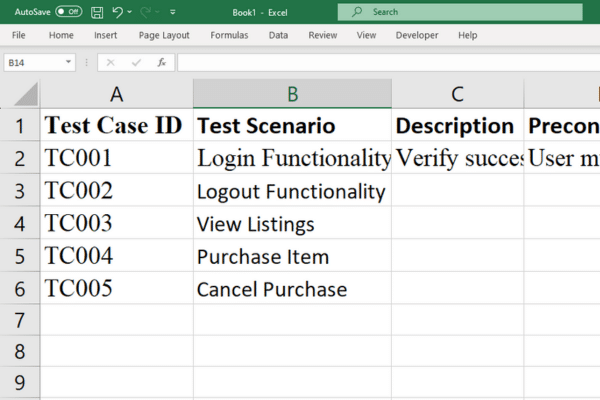
Creating a test case template in Excel can help streamline the process of writing and organizing test cases for software testing projects.
Follow these steps to create a simple and effective test case template in Excel:
Consider including headers such as:
Format the headers to make them visually distinct by bolding the text, changing the font size, or using a different background color. This will help testers easily navigate the document.
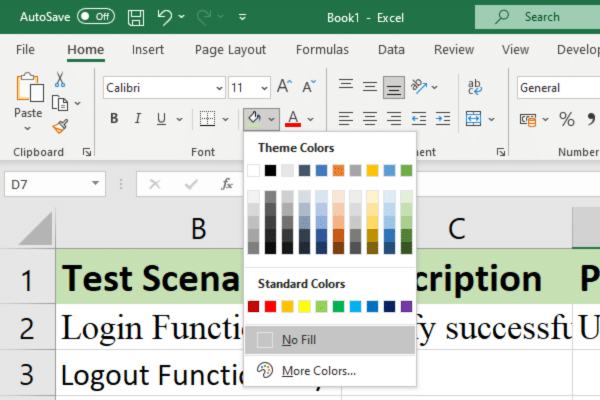
Add rows for each test case and provide a unique ID with a brief description of the purpose of the test.
Here is some sample data for a test case before it is executed (i.e. without the results yet).
As you add test steps, be specific about the actions that need to be performed and any required test data.
Use the ‘Test Data’ column to list any input data or variables that are relevant to the given test steps.
Once your test scenarios are defined in the template, they can be executed by testers.
Results should be documented in the ‘Actual Result’ column, and the status should be updated to indicate success or failure.
Use the ‘Comments’ column for any observations or notes on the test case.
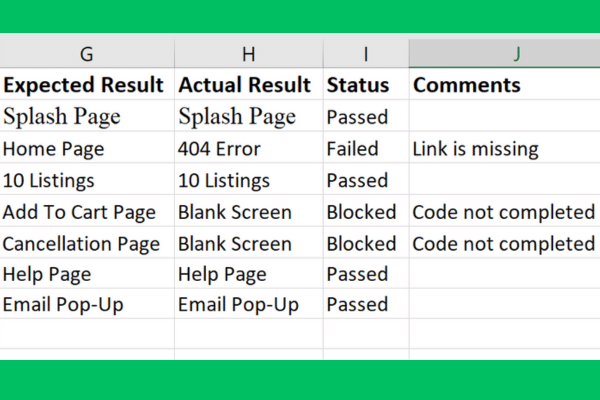
Writing effective test cases in Excel requires understanding and defining the essential components of a test plan template. Let’s look at each in turn.
Assigning a unique Test Case ID to each test case is crucial for identification and tracking purposes.
The ID number aids in quick referencing, making it effortless for team members to track the progress or discuss specific test cases with colleagues.
A clear and concise Test Case Description outlines the purpose of the test case.
It describes what part of the application is being tested and the expected outcome, making it easy for testers to comprehend the context and objectives.
Test Steps define a series of actions that need to be performed to execute the test case.
All the test steps should be clear and detailed to ensure that testers follow a consistent process. This reduces the risk of ambiguities, errors, and misinterpretations.
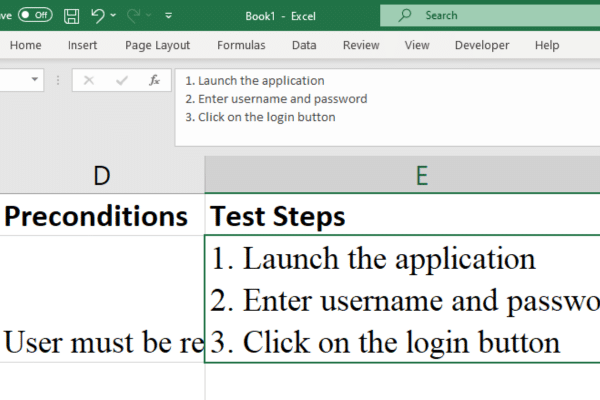
The Expected Results component highlights the outcome that should occur after completing the Test Steps.

This information is vital for testers to determine if the application is performing as expected and adhering to the predefined requirements.
Upon completion of the Test Steps, testers will document the Actual Results of the test case.
By comparing the Actual Results with the Expected Results in the Excel sheet, testers can quickly identify discrepancies, deviations, or potential issues within the application.
Test Status indicates the outcome of a test case execution, such as:
This component enables team members to track the test case progress and overall testing status throughout the project.
The Comments section provides an opportunity for testers to add additional notes or highlight any specific concerns regarding the test case.
This information may include details about encountered issues, suggestions for improvements, or any other relevant observations made during the testing process.
Here are our five top recommendations for writing effective test cases in Excel.
When writing test cases in Excel, simplicity is key. Evaluate the test scenario and identify the specific area you’d like to cover.
By breaking down the scenario into smaller, manageable pieces, you make the process more approachable for testers.
It’s essential to write test cases that are easy to understand and execute. This can be achieved by using clear language, concise instructions, and a structured layout.
Be specific in your functional test cases by identifying the exact steps, conditions, and requirements. Include the necessary details such as scenario, action, test data, and expected result.
When outlining test data, ensure you have both valid and invalid data sets ready. This will help improve coverage and reduce the likelihood of errors slipping through unnoticed.
Ensure your test cases are traceable by using a unique test case ID, which will help distinguish between different test cases and scenarios.
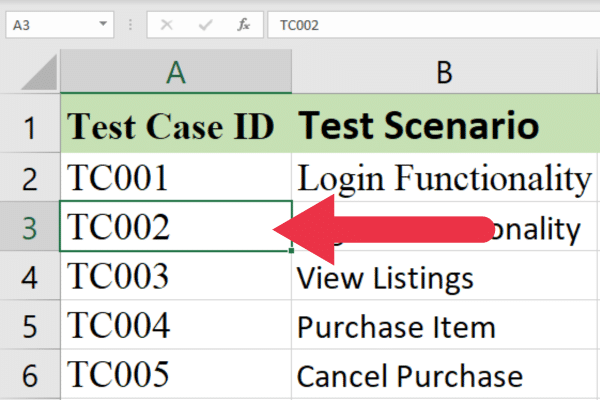
Traceability also involves linking test cases to requirements, which allows for a systematic approach to identifying gaps in testing, impact analysis, and prioritization.
In order to optimize the testing process, focus on reusability when writing test cases in Excel. Design your test cases in a way that they can be reused for different scenarios with minimal modifications.
This can be achieved by leveraging modular test steps and minimizing hard-coded values. Reusability not only saves time but also promotes consistency across different tests and projects.
Write test cases in a way that they are independent of each other, allowing testers to run them in any sequence. Test cases should be designed in such a way that the outcome of one test case should not impact the execution of other test cases.
This strategy ensures that each test case can stand on its own, leading to more efficient and effective testing.
As you prepare your test plans, plan how you intend to organize, update, and share your test cases. Here are some aspects to consider.

Consider using a naming convention for test cases and test IDs.
For instance, generic test cases can start with “TEST_ID 1,” while test cases related to specific modules can start with “MOD_ID 1.”
If a test case has multiple expected outcomes, use sub-IDs, like “TEST_ID 1.1” and “TEST_ID 1.2.”
As your project evolves, it’s crucial to regularly update your test cases to reflect any changes in requirements, functionality, or test data.
Excel makes it simple to modify and adjust test cases as needed. Make sure to update both the action and expected results for each test case when changes occur.
Collaboration is a critical part of the testing process, so sharing test cases with your team is essential.
You can use Microsoft Excel’s built-in sharing features to ensure that the appropriate colleagues can access the Excel file.
If you’re using Sharepoint, here is how to refresh your Excel worksheets:

You should consider whether a dedicated test case management tool would be more appropriate for your specific test case scenario.
While using Excel for test case management is popular and effective, there are other test management tools and platforms available to help manage test cases more efficiently.
Here are four to review:

TestRail is a comprehensive test case management tool, designed specifically for managing, tracking, and organizing test cases.
It provides real-time insights and analytics, and integration with defect trackers.
Jira is a widely used project management and issue-tracking platform, which can also be used for test case management.
With various plugins and integrations available, such as Zephyr or Xray, Jira can be customized to support test case management. This makes it a flexible and scalable alternative to Excel.
QTest is a test case management platform, offering a centralized platform for creating, executing, and managing test cases.
Its integration with popular automation testing tools makes it an effective alternative to Excel.
PractiTest is a cloud-based test case management tool. It offers a range of features for managing test cases, including hierarchical organization, test execution, and defect tracking.

This guide will help you learn how to use the SUMPRODUCT function in Excel for calculating weighted averages, with practical examples and clear instructions.

Unlock the full potential of Excel with this comprehensive guide to mastering shortcuts. Improve your productivity and streamline your workflow with key combinations.

Learn how to use VBA in Excel to efficiently manage transportation data.

A project focused on implementing an extensive VBA-based inventory management system within an Excel spreadsheet to streamline data handling.

This project aims to streamline and boost efficiency in Excel spreadsheet tasks using VBA arrays.

Learn to analyze and summarize complex data using Excel’s powerful Pivot Table feature.

This project teaches how to manage and automate financial data in Excel using VBA programming.

Hey there, fellow Mac users! Have you ever wondered how you can level up your data management game with.

As a data analyst or a spreadsheet enthusiast, you’re probably familiar with the many ways Excel can.

One of the best things about Excel is how quickly and easily it can add up all the numbers in a column.

In data analysis, interpolation plays a crucial role in estimating values that fall between known data.

So you're looking to learn Excel, one of the most widely used software applications in the.